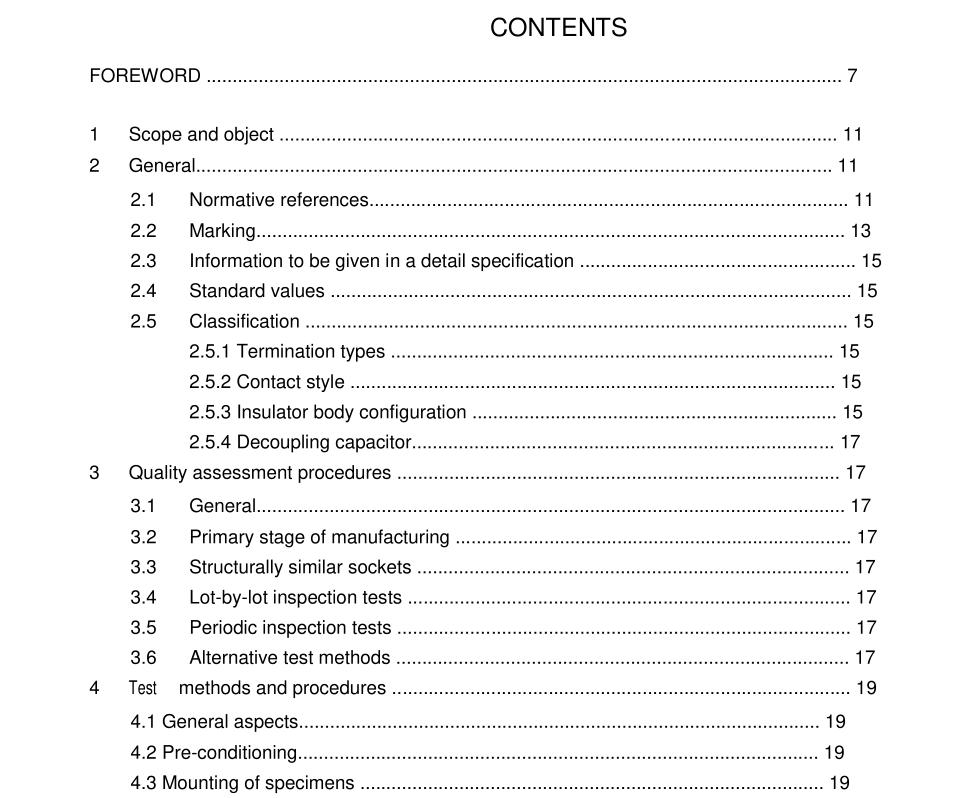IEC 61076-5 pdf download

IEC 61076-5 pdf download.Connectors for use in d.c., low-frequency analogue and digital high-speed data applications
1 Scope and object
This part of IEC 61076 relates to the plug-in sockets designed for in-line electronic packages of assessed quality. Sockets covered by this specification are devices which provide a means of interchangeability between devices and compliance between mating limits. The scope of this specification covers sockets for packages with contacts having one of the following in-line formats. a) Single in-line sockets. b) Dual in-line sockets. c) Quad in-line sockets. d) Zig-zag in-line (staggered) sockets. The object of this specification is to define ● a unified numbering system; . ● functional levels and standard test methods and gauges for use in the examination of these sockets; ● appropriate reference dimensions of the mating device and board layout to establish intermateability and interchangeability criteria. Test severity and performance require- ments prescribed in detail specifications referring to this sectional specification shall be equal to, or greater than, those specified herein; degradations are not permitted.
2,General
2.1 Normative references The following normative documents contain provisions which, through reference in this text, constitute provisions of this part of IEC 61076. For dated references, subsequent amendments to, or revisions of, any of these publications do not apply. However, parties to agreements based on this part of IEC 61076 are encouraged to investigate the posibility of applying the most recent editions of the normative documents indicated below. For undated references, the latest edition of the normative document referred to applies. Members of IEC and ISO maintain registers of currently valid International Standards. IEC 60068-1:1988, Environmental testing – Part 1: General and guidance IEC 60352 (all parts), Solderless connections IEC 60410:1973, Sampling plans and procedures for inspection by attributes
2.3 Information to be given in a detail specification The detail specification shall be derived from the relevant blank detail specification and shall contain all required information. Detail specifications shall not specify requirements inferior to those of the generic or sectional specifications. When more severe requirements are included, they shall be listed in the detail specification and indicated in the test schedules; for example, by an asterisk. The detail specification shall contain the complete technical requirements for inspection, including the quality conformance test schedule. If the technical requirements of the generic and/or sectional specification relative to inspection are not entirely suitable (either for technical reasons or for special applications) to the component described in the detail specification, the detail specification shall set out clearly the various amendments which are to be made to these requirements. 2.4 Standard values The range for voltage shall not exceed 1 000 V (d.c. or peak a.c.). The current rating shall not exceed 2 A. Specific voltage and current ratings shall be as defined in the detail specification. 2.5 Classification Sockets covered by this sectional specification shall be classified with respect to termination type, contact style, insulator body configuration, and decoupling capacitor style.
3 Quality assessment procedures
3.1 General The qualification inspection tests are prescribed in table 2. When aditional test groups are prescribed by the detail specification, the identity of the test group, the sequence of tests, and the minimum sample quantity shall be in accordance with table 2. When the detail specification prescribes tests not in table 2, it shall include the additional test either within an existing test group or as an additional test group. No failures are permitted. In the event that qualfication is sought on a variant of a previously qualified socket, qualification inspection shall be limited to those tests for which the test results on previously qualified sockets are not valid for the variant. 3.2 Primary stage of manufacturing The primary stage of manufacture is the first process subsequent to the manufacture of finished piece parts and subassemblies. A subassembly is defined as the permanent assembly of two or more piece parts.









